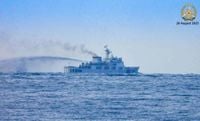In the contested waters of the South China Sea, tensions have surged yet again as China deployed a formidable force of armed coast guard ships, maritime militia vessels, and fast boats near the Second Thomas Shoal—known locally in the Philippines as Ayungin Shoal—on August 20 and 21, 2025. The deployment, which included a helicopter and an unmanned aerial vehicle, marks a significant escalation in the ongoing standoff between Beijing and Manila, drawing in regional allies and prompting international concern.
The Armed Forces of the Philippines (AFP) reported that three Chinese boats mounted with armaments, alongside five China Coast Guard (CCG) vessels, 11 rigid hull inflatable boats, and nine maritime militia vessels, were observed close to the BRP Sierra Madre. This Philippine Navy ship was deliberately grounded at the shoal in 1999 and has since served as a makeshift outpost—both a symbol and a practical assertion of Manila’s claim to the territory. According to Cebudailynews, these Chinese vessels were seen conducting water cannon drills, with one vessel deploying fishnets along the southeast approach of the shoal. A Chinese navy helicopter and a drone hovered above, intensifying the atmosphere of intimidation.
Philippine troops stationed aboard the BRP Sierra Madre witnessed the Chinese boats maneuvering dangerously close—within 50 meters—prompting an immediate response. Video footage, as reported by Naval News, showed two Philippine rubber boats circling a small, heavily armed Chinese boat to prevent it from approaching the outpost. This was not a simple standoff: the Chinese boat was equipped with a heavy machine gun, and the Philippine troops were visibly determined to hold their ground.
Rear Admiral Roy Vincent Trinidad, Philippine Navy spokesperson for the West Philippine Sea, described the situation bluntly: “This is a form of intimidation. They are trying to coerce us by showing their capability… We’ve been here before. Our soldiers are undaunted and are convinced of the legitimacy of our stand.” His words echo a sentiment of resilience that has become necessary in the face of repeated confrontations.
This latest episode comes barely a week after a collision near the Scarborough Shoal (locally known as Panatag Shoal), another flashpoint in the South China Sea. That incident, involving a China Coast Guard ship and a People’s Liberation Army-Navy warship, reportedly resulted in damage to both Chinese navy and coast guard vessels, though Beijing has yet to officially acknowledge the collision. The frequency and intensity of these confrontations have raised alarms among regional observers and policymakers alike.
The backdrop to these recent events is a fraught history of violent encounters. On June 17, 2024, a particularly brutal episode unfolded during a rotation and resupply (Rore) mission to the BRP Sierra Madre. Chinese forces punctured, boarded, and towed Philippine vessels, leading to the severing of a Philippine Navy sailor’s thumb. The following month, a provisional arrangement was reached between the two countries to de-escalate tensions at Ayungin, but the uneasy peace has proven short-lived.
Philippine Defense Secretary Gilberto Teodoro did not mince words in his condemnation of China’s actions. During a joint press conference with Australian Defense Minister Richard Marles, Teodoro declared, “We need to stand up to this.” He emphasized that China’s assertiveness is not only a violation of Philippine sovereignty but also an affront to the international rules-based order. Teodoro’s remarks reflect a growing consensus within the Philippine government that firm resistance is necessary to counter Beijing’s expansive territorial claims.
Australia, for its part, has thrown its weight behind the Philippines. Minister Marles reaffirmed his country’s commitment to supporting Manila in upholding the rule of law in the region. As part of this support, large-scale military exercises—dubbed Alon, meaning “wave” in Tagalog—are currently underway. These drills feature Australian guided-missile destroyers, fighter jets, and specialized troops, and are designed to enhance interoperability and collective deterrence between the two nations. Both defense ministers signed a joint letter of intent to deepen defense cooperation, sending a clear signal to Beijing that Manila is not standing alone.
China, meanwhile, has responded with familiar rhetoric. The China Coast Guard accused the Philippines of “infringement activities, provocations, and false accusations,” as reported by state-run Xinhua. A CCG spokesperson insisted that their law enforcement operations in the waters of Ren’ai Jiao—China’s name for Second Thomas Shoal—would continue and that they would “resolutely defend” national sovereignty and maritime rights. The Chinese side’s refusal to acknowledge its own aggressive deployments, while calling for an immediate cessation of Philippine activities, underscores the intractable nature of the dispute.
The strategic importance of Second Thomas Shoal cannot be overstated. Located just 105 nautical miles off Palawan, it lies well within the Philippines’ exclusive economic zone, an area whose boundaries were affirmed by the landmark 2016 Arbitral Award at The Hague. This ruling, which Beijing has repeatedly dismissed, found in Manila’s favor and declared that China’s sweeping claims to nearly the entire South China Sea have no basis in international law. Despite this, China has continued to enforce what experts term “exclusion zone enforcement” not only at Ayungin but also at Scarborough Shoal, where it restricts access to traditional fishing grounds used by the Philippines, China, and Vietnam.
The risks associated with these maritime confrontations are not lost on the international community. Analysts warn that the close proximity of armed vessels, the presence of military aircraft and drones, and the growing number of outside actors—including Australia and, by extension, the United States—raise the specter of a wider conflict sparked by miscalculation or accident. The ongoing military exercises and the signing of new defense agreements are seen by some as necessary deterrents, but others worry they could further inflame an already volatile situation.
For the time being, the AFP has confirmed that there is no scheduled rotation and resupply mission to Ayungin, following the violence of the June 2024 mission. The National Maritime Council noted that the last such mission occurred in June 2025, and military officials remain vigilant, with contingency measures in place for any eventuality. As General Romero Brawner Jr., the Philippine military chief, put it, the state of affairs remains tense, with Filipino troops committed to pushing back against encroaching Chinese forces.
With each new standoff, the stakes grow higher—not just for the Philippines and China, but for the entire region. The world watches closely, hoping that restraint and dialogue will prevail over force and coercion, even as the ships and soldiers remain locked in a dangerous dance at sea.






